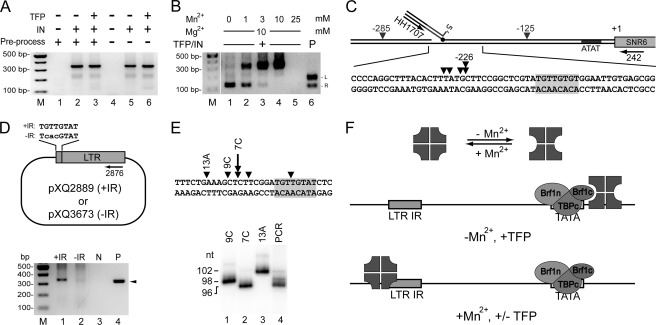FIGURE 4.
Ty3 IN mediates sequence-specific targeting in the presence of MnCl2. A, Ty3 IN strand-transfer in the presence of MnCl2 is TFP independent. Strand transfer reactions and analysis were performed as described in the Fig. 2 legend except that 10 mm MnCl2 replaced MgCl2 and PCR products were resolved on a 1.5% agarose gel. B, appearance of novel strand-transfer product is dependent upon MnCl2. Reactions as described in A performed in the presence of 10 mm MgCl2 and MnCl2 concentrations from 0 to 25 mm (lanes 1–5). Plasmids pXQ3659 and pXQ3660 were used as control for strand-transfer positions under MgCl2-containing conditions (lane 6). PCR products were analyzed as in A. C, MnCl2-dependent strand transfer targets vicinity of sequences similar to Ty3 IR. PCR reactions were performed as described above (A, lane 3), and products were sequenced and labeled in diagram as described in the Fig. 2 legend. Target plasmid Ty3 IR (5′-TGTTGTAT-3′/5′-ATACAACA-3′)-like sequence, shaded box. D, MnCl2-dependent strand-transfer targets Ty3 IR. Upper panel, plasmids containing Ty3 LTR lacking the downstream inverted repeat and wt (+IR) (pXQ2889) or mutated (−IR) (pXQ3673) IR were tested for targeting activity. Lower panel, reaction conditions and assay were as described above (A, lane 3) with pre-processed Ty3 U5 duplex oligonucleotide substrate. Insertions were analyzed using the same forward primer (HH1707) and a reverse primer (XQ2876) annealed downstream of the Ty3 IR. Control PCR used pXQ3661 containing a Ty3 U5 end upstream of the IR sequence as template (P). DNA recovery was monitored by PCR using primers XQ2876 and XQ2877 (data not shown). PCR products were analyzed as in A. E, strand transfer is imprecise and proximal to the outside end of the Ty3 IR. PCR amplicons (D, lane 1) were cloned and sequenced allowing identification of products with strand transfers at positions −7(C), −9(C), and −13(A). These clones (lanes 9C, 7C, and 13A) and the total original reaction products (as described for D, lane 1) were used to template 32P-labeling PCR using primers XQ2876/XQ3135. Products were resolved on a 10% denaturing polyacrylamide gel. F, model for differential sequence or transcription complex targeting by Ty3 IN. Ty3 IN adopts different states in the presence or absence of MnCl2 (top). In the absence of MnCl2, TFP recruits IN (middle). IN conformation in MnCl2 prevents interaction with TFP and allows association of IN subunits not interacting with substrate to interact with target (bottom).

